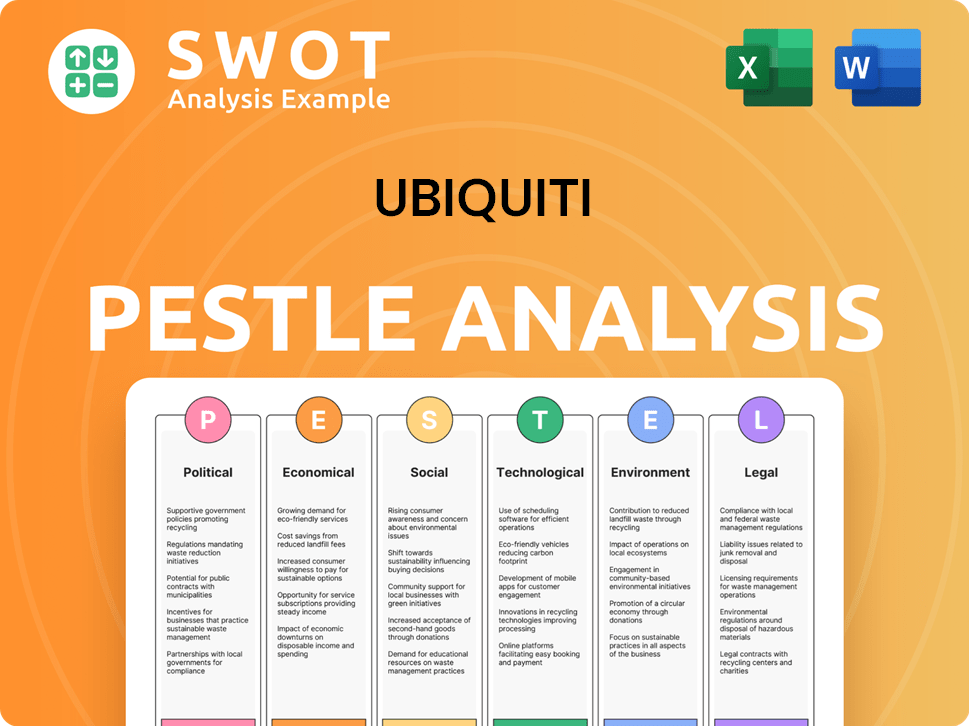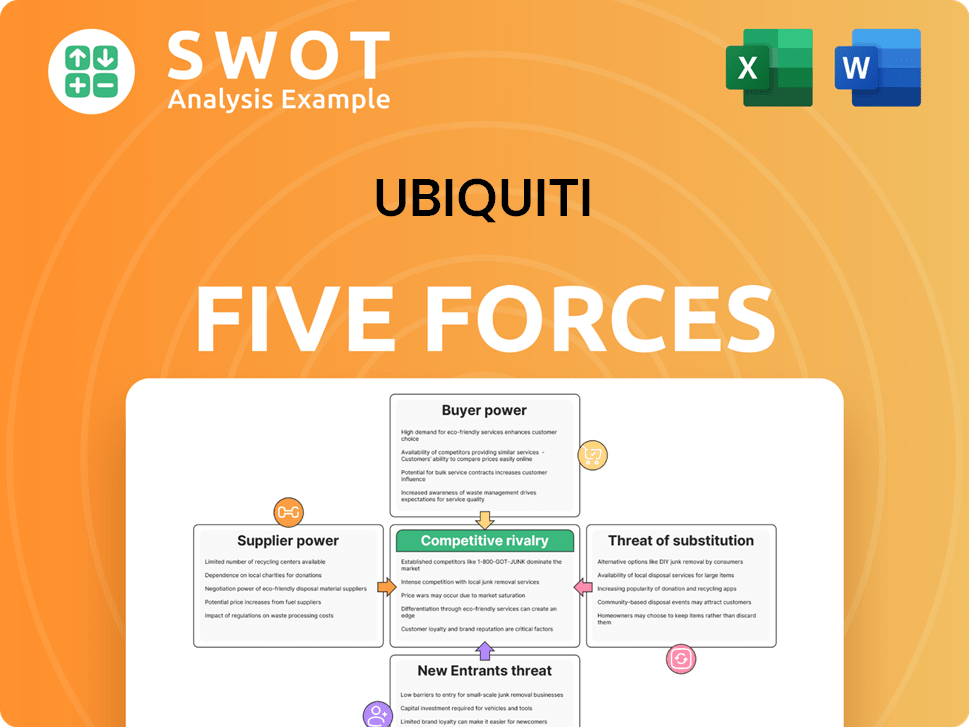Ubiquiti Bundle
How Did Ubiquiti Disrupt the Networking World?
Ever wondered how a company could shake up the tech industry with a fresh approach? Ubiquiti, formerly known as Ubiquiti Networks, did just that, revolutionizing wireless networking. Founded in 2005, this company dared to challenge established giants, offering high-performance solutions at a fraction of the cost. This Ubiquiti SWOT Analysis reveals the strategies behind their impressive rise.

From its early days, Ubiquiti's focus on underserved markets and affordable technology set it apart. This brief history of Ubiquiti Networks explores their journey from a startup to a global player in wireless networking. Understanding Ubiquiti's evolution provides valuable insights for anyone interested in technology, business, or investment.
What is the Ubiquiti Founding Story?
The story of the Ubiquiti Networks begins with a vision to make high-performance wireless networking accessible to everyone. Founded in 2005, the company quickly made its mark by offering cost-effective solutions that rivaled more expensive enterprise-grade equipment.
This approach allowed Ubiquiti to capture a significant share of the market. By focusing on innovation and customer feedback, the company has grown into a major player in the networking industry. The company's early success laid the groundwork for its future expansion and influence.
Robert Pera, an engineer from Apple Inc., founded Ubiquiti Networks, Inc. on October 24, 2005. He aimed to create affordable, high-performance wireless networking equipment. The initial focus was on providing carrier-class wireless solutions to underserved areas.
- Pera's background in electrical engineering from Apple provided technical expertise.
- The company's first product was the Super Range series of mini-PCI radio cards.
- Ubiquiti's initial funding came from bootstrapping, using Pera's savings and early revenues.
- The name 'Ubiquiti' reflects the goal of ubiquitous connectivity.
Ubiquiti SWOT Analysis
- Complete SWOT Breakdown
- Fully Customizable
- Editable in Excel & Word
- Professional Formatting
- Investor-Ready Format

What Drove the Early Growth of Ubiquiti?
The early growth of the Ubiquiti company was marked by rapid expansion and a strategic market penetration approach, especially within the Wireless Internet Service Provider (WISP) community. Following the success of the initial Super Range series, the company introduced the AirMax line in 2008, which revolutionized outdoor wireless networking. This innovation solidified Ubiquiti's reputation as a leader in cost-effective, long-range wireless solutions. Early sales were driven by strong word-of-mouth within the WISP industry.
The company quickly expanded its product portfolio. The introduction of the AirMax line in 2008, featuring a TDMA protocol, significantly improved throughput and scalability. This expansion allowed Ubiquiti to address a broader range of networking needs.
Ubiquiti focused on aggressive market penetration, particularly within the WISP community. The company's equipment offered a reliable and affordable alternative to traditional vendors. This strategy helped Ubiquiti gain a strong foothold in the market.
The company strategically entered new geographical markets, focusing on regions with high demand for affordable internet infrastructure. By leveraging its distribution network, Ubiquiti expanded its reach. This expansion was crucial for its growth.
Ubiquiti went public on the NASDAQ stock exchange in October 2011. This IPO raised significant capital for further research, development, and market expansion. For more details on the company's ownership and financial structure, you can read more at Owners & Shareholders of Ubiquiti.
Ubiquiti PESTLE Analysis
- Covers All 6 PESTLE Categories
- No Research Needed – Save Hours of Work
- Built by Experts, Trusted by Consultants
- Instant Download, Ready to Use
- 100% Editable, Fully Customizable

What are the key Milestones in Ubiquiti history?
The history of the Ubiquiti company, also known as Ubiquiti Networks, is marked by significant milestones that have shaped its trajectory in the wireless networking industry. From its inception, the company has consistently pushed boundaries, achieving notable advancements and solidifying its position in the market. These accomplishments underscore Ubiquiti's commitment to innovation and its ability to adapt to the ever-changing demands of the technology sector.
| Year | Milestone |
|---|---|
| 2005 | Founded by Robert Pera, Ubiquiti began with a focus on providing high-performance wireless networking solutions. |
| 2007 | Ubiquiti launched its first significant product, the NanoStation, which quickly gained popularity for its performance and affordability in the wireless networking market. |
| 2010 | The introduction of the UniFi product line marked a pivotal moment, bringing enterprise-grade Wi-Fi with centralized management to a broader market, particularly small and medium-sized businesses. |
| 2011 | Ubiquiti went public, listing on the NASDAQ, which provided capital for further expansion and innovation. |
| 2017 | The company expanded its product offerings with the launch of the UniFi Protect line, entering the surveillance camera market and further integrating its ecosystem. |
| 2020-2024 | Ubiquiti continued to release new products and software updates, expanding its product lines and improving its existing offerings. |
Ubiquiti has consistently focused on innovation, particularly in wireless networking and related technologies. Its approach involves developing high-performance, cost-effective solutions that cater to a wide range of users, from individual consumers to large enterprises. This commitment to innovation has allowed Ubiquiti to remain competitive and meet evolving market demands.
The UniFi line brought enterprise-grade Wi-Fi to a broader audience, offering centralized management and scalability at a competitive price point. This innovation disrupted the market and established Ubiquiti as a key player in the SMB sector.
AirMax technology provided high-performance, long-range wireless connectivity solutions, ideal for point-to-point and point-to-multipoint applications. This technology has been crucial for service providers and businesses needing reliable wireless links.
UniFi Protect expanded Ubiquiti's ecosystem into surveillance, offering a comprehensive video security solution with easy management and integration. This move diversified the company's product offerings and increased its market reach.
Ubiquiti has increasingly focused on a direct-to-consumer model, allowing for greater control over brand messaging and customer experience. This shift has enabled the company to build stronger relationships with its user base.
AirFiber technology offers high-capacity, long-distance wireless backhaul solutions, essential for service providers and businesses requiring robust data transmission. This technology has been critical for Ubiquiti's success in the wireless infrastructure market.
Ubiquiti's embrace of SDN principles has enabled centralized management and control of its network devices, simplifying network administration and improving overall performance. This approach has been key to the company's success in the enterprise market.
Despite its successes, Ubiquiti has faced various challenges throughout its history. These challenges have tested its resilience and forced the company to adapt and innovate. Navigating these obstacles has been crucial for maintaining its competitive edge and ensuring sustained growth.
Intense competition from established networking giants and emerging low-cost manufacturers has put pressure on Ubiquiti's market share. The company must continuously innovate and offer competitive pricing to maintain its position.
Ubiquiti has faced supply chain disruptions, particularly during global events, which have impacted its ability to meet demand. Managing these disruptions requires careful planning and diversification of suppliers.
Product failures or security vulnerabilities, though rare, can damage customer trust and require swift responses. The company must prioritize quality control and cybersecurity to maintain its reputation.
Rapid changes in market trends and technological advancements require Ubiquiti to be agile and responsive. The company must continuously adapt its product offerings and business strategies to stay ahead.
Protecting the brand's reputation is crucial, especially when dealing with product recalls or security breaches. Consistent communication and proactive customer support are essential to maintaining trust.
The shift towards a direct-to-consumer model presents challenges in terms of customer service, marketing, and distribution. Ubiquiti must invest in these areas to ensure a positive customer experience.
Ubiquiti Business Model Canvas
- Complete 9-Block Business Model Canvas
- Effortlessly Communicate Your Business Strategy
- Investor-Ready BMC Format
- 100% Editable and Customizable
- Clear and Structured Layout

What is the Timeline of Key Events for Ubiquiti?
The Ubiquiti history is marked by significant product launches and strategic shifts. Founded by Robert Pera on October 24, 2005, the company, initially known as Ubiquiti Networks, quickly made its mark in the wireless networking sector. The introduction of the AirMax product line in 2008 revolutionized outdoor wireless communications. Further expansion occurred with the UniFi product line in 2010, offering affordable enterprise Wi-Fi solutions. Ubiquiti went public in October 2011, and the EdgeMAX line was launched in 2012, followed by the UniFi Protect line in 2017, expanding into surveillance. In 2019, the company officially changed its name to Ubiquiti Inc. The company reported a net income of $169.6 million for Q2 FY2024, demonstrating continued profitability.
| Year | Key Event |
|---|---|
| 2005 | Robert Pera founded Ubiquiti Networks, Inc. |
| 2008 | The AirMax product line was launched, changing outdoor wireless networking. |
| 2010 | Ubiquiti introduced the UniFi product line, bringing affordable enterprise Wi-Fi to the market. |
| 2011 | Ubiquiti went public on the NASDAQ stock exchange in October. |
| 2012 | The EdgeMAX line was released for routing and switching solutions. |
| 2017 | Ubiquiti expanded into surveillance with the UniFi Protect line. |
| 2019 | The company officially changed its name to Ubiquiti Inc. |
| 2020-2022 | Ubiquiti navigated global supply chain issues and increased its focus on direct-to-consumer sales. |
| 2023-2024 | Ubiquiti continued to expand the UniFi ecosystem, with new access points, switches, and security gateways, often using Wi-Fi 6E and Wi-Fi 7 technologies. |
Ubiquiti is focused on expanding its integrated ecosystem, particularly within the UniFi platform. This expansion aims to provide more comprehensive solutions for smart homes, businesses, and service providers. The strategy includes the development of new products and features to enhance user experience and functionality. This approach allows Ubiquiti to offer more complete and integrated solutions.
Innovation in wireless technologies, including Wi-Fi 7 and beyond, is a key area of focus for Ubiquiti. The company is continuously working on enhancing the performance and capabilities of its wireless networking products. These advancements are crucial for meeting the increasing demand for high-speed internet and supporting the growing number of IoT devices. Continued innovation helps to maintain a competitive edge.
Ubiquiti plans to deepen its presence in existing markets and explore new geographical regions. This expansion strategy is intended to increase the company's overall market share. By expanding its reach, Ubiquiti can capitalize on the growing demand for reliable and advanced networking solutions. This growth is supported by a strong brand reputation and competitive pricing.
Industry trends, such as the rising demand for high-speed internet and the growth of IoT devices, will significantly impact Ubiquiti's future. The need for robust and secure network infrastructure is also a key driver. Analysts predict continued growth for Ubiquiti, supported by strong brand loyalty and product innovation. These trends create opportunities for the company to expand its market presence.
Ubiquiti Porter's Five Forces Analysis
- Covers All 5 Competitive Forces in Detail
- Structured for Consultants, Students, and Founders
- 100% Editable in Microsoft Word & Excel
- Instant Digital Download – Use Immediately
- Compatible with Mac & PC – Fully Unlocked

Related Blogs
- What is Competitive Landscape of Ubiquiti Company?
- What is Growth Strategy and Future Prospects of Ubiquiti Company?
- How Does Ubiquiti Company Work?
- What is Sales and Marketing Strategy of Ubiquiti Company?
- What is Brief History of Ubiquiti Company?
- Who Owns Ubiquiti Company?
- What is Customer Demographics and Target Market of Ubiquiti Company?
Disclaimer
All information, articles, and product details provided on this website are for general informational and educational purposes only. We do not claim any ownership over, nor do we intend to infringe upon, any trademarks, copyrights, logos, brand names, or other intellectual property mentioned or depicted on this site. Such intellectual property remains the property of its respective owners, and any references here are made solely for identification or informational purposes, without implying any affiliation, endorsement, or partnership.
We make no representations or warranties, express or implied, regarding the accuracy, completeness, or suitability of any content or products presented. Nothing on this website should be construed as legal, tax, investment, financial, medical, or other professional advice. In addition, no part of this site—including articles or product references—constitutes a solicitation, recommendation, endorsement, advertisement, or offer to buy or sell any securities, franchises, or other financial instruments, particularly in jurisdictions where such activity would be unlawful.
All content is of a general nature and may not address the specific circumstances of any individual or entity. It is not a substitute for professional advice or services. Any actions you take based on the information provided here are strictly at your own risk. You accept full responsibility for any decisions or outcomes arising from your use of this website and agree to release us from any liability in connection with your use of, or reliance upon, the content or products found herein.